ECU HONDA PASSPORT 2002 2.G Owners Manual
[x] Cancel search | Manufacturer: HONDA, Model Year: 2002, Model line: PASSPORT, Model: HONDA PASSPORT 2002 2.GPages: 294, PDF Size: 3.97 MB
Page 12 of 294
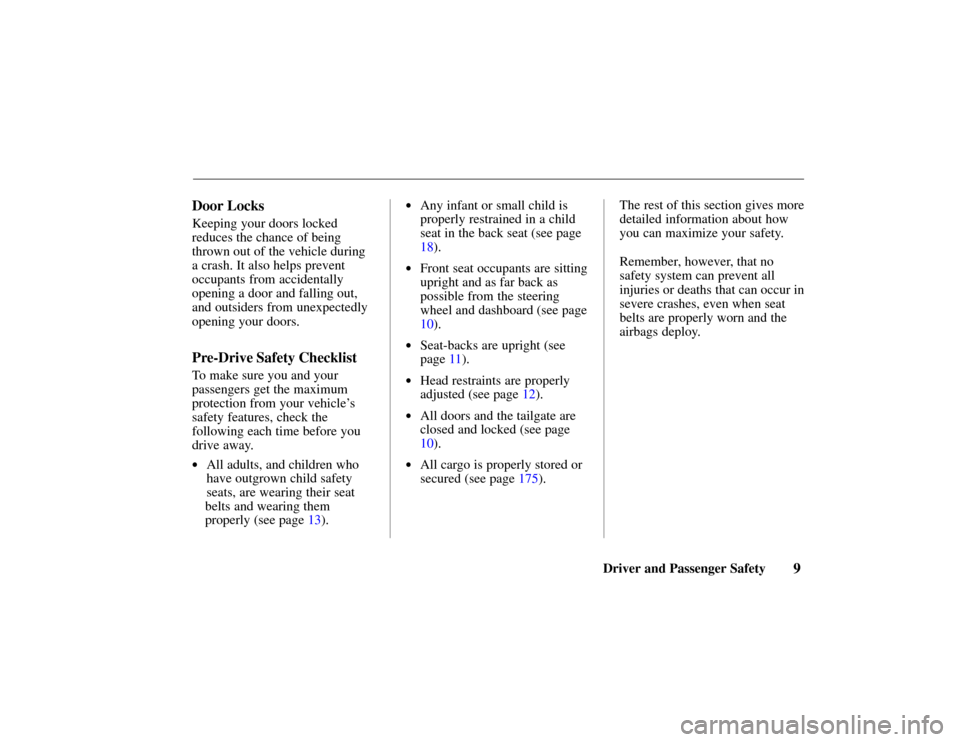
belts and wearing them
properly (see page 13).
9Driver and Passenger Safety
Door Locks
Keeping your doors locked
reduces the chance of being
thrown out of the vehicle during
a crash. It also helps prevent
occupants from accidentally
opening a door and falling out,
and outsiders from unexpectedly
opening your doors.
Pre-Drive Safety Checklist
To make sure you and your
passengers get the maximum
protection from your vehicle’s
safety features, check the
following each time before you
drive away.
•All adults, and children who
have outgrown child safety
seats, are wearing their seat
•Any infant or small child is
properly restrained in a child
seat in the back seat (see page
18).
•Front seat occupants are sitting
upright and as far back as
possible from the steering
wheel and dashboard (see page
10).
•Seat-backs are upright (see
page 11).
•Head restraints are properly
adjusted (see page 12).
•All doors and the tailgate are
closed and locked (see page
10).
•All cargo is properly stored or
secured (see page 175). The rest of this section gives more
detailed information about how
you can maximize your safety.
Remember, however, that no
safety system can prevent all
injuries or deaths that can occur in
severe crashes, even when seat
belts are properly worn and the
airbags deploy.
Page 13 of 294

10Driver and Passenger Safety
Introduction
The following pages provide
instructions on how to properly
protect the driver and other adult
occupants.
These instructions also apply to
children who have outgrown child
seats and are large enough to wear
lap/shoulder belts. (See page 34
for important additional
guidelines on how to properly
protect larger children.)
1. Close and Lock the Doors
After everyone has entered the
vehicle, be sure the doors and
tailgate are closed and locked.
For safety, locking the doors
reduces the chance that a
passenger, especially a child, will
open a door while the vehicle is
moving and accidentally fall out.It also reduces the chance of
someone being thrown out of the
vehicle during a crash.
For security, locked doors can
prevent an outsider from
unexpectedly opening a door
when you come to a stop.
See page 104 for how to lock the
doors.
2. Adjust the Front Seats
Any driver who sits too close to
the steering wheel is at risk of
being seriously injured or killed
by striking the steering wheel, or
from being struck by the inflating
airbag during a crash.
Protecting Adults
Page 16 of 294
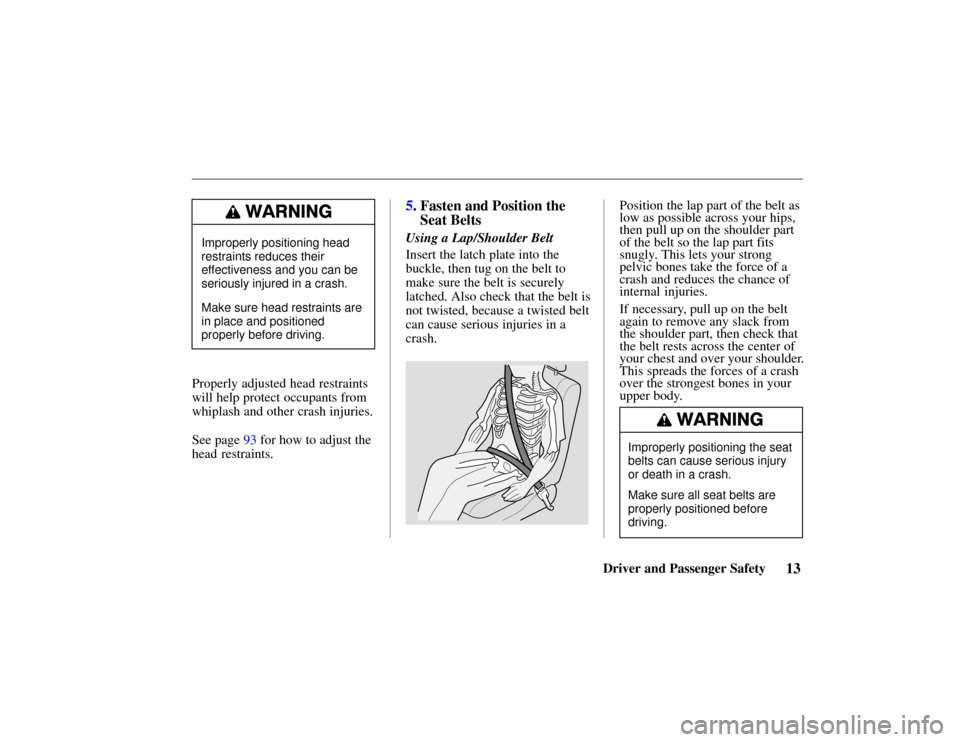
13Driver and Passenger Safety
Improperly positioning head
restraints reduces their
effectiveness and you can be
seriously injured in a crash.
Make sure head restraints are
in place and positioned
properly before driving.
Properly adjusted head restraints
will help protect occupants from
whiplash and other crash injuries.
See page 93 for how to adjust the
head restraints.
5. Fasten and Position theSeat Belts
Using a Lap/Shoulder Belt
Insert the latch plate into the
buckle, then tug on the belt to
make sure the belt is securely
latched. Also check that the belt is
not twisted, because a twisted belt
can cause serious injuries in a
crash.
Position the lap part of the belt as
low as possible across your hips,
then pull up on the shoulder part
of the belt so the lap part fits
snugly. This lets your strong
pelvic bones take the force of a
crash and reduces the chance of
internal injuries.
If necessary, pull up on the belt
again to remove any slack from
the shoulder part, then check that
the belt rests across the center of
your chest and over your shoulder.
This spreads the forces of a crash
over the strongest bones in your
upper body.
Improperly positioning the seat
belts can cause serious injury
or death in a crash.
Make sure all seat belts are
properly positioned before
driving.
Page 18 of 294
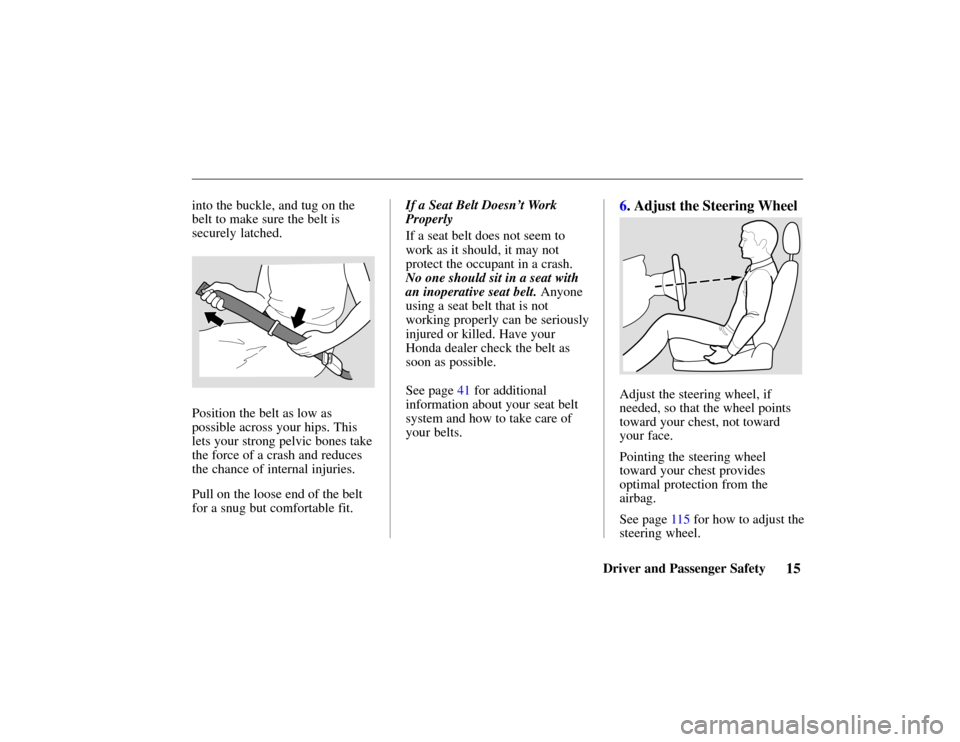
15Driver and Passenger Safety
into the buckle, and tug on the
belt to make sure the belt is
securely latched.
Position the belt as low as
possible across your hips. This
lets your strong pelvic bones take
the force of a crash and reduces
the chance of internal injuries.
Pull on the loose end of the belt
for a snug but comfortable fit.
If a Seat Belt Doesn’t Work
Properly
If a seat belt does not seem to
work as it should, it may not
protect the occupant in a crash.
No one should sit in a seat with
an inoperative seat belt.
Anyone
using a seat belt that is not
working properly can be seriously
injured or killed. Have your
Honda dealer check the belt as
soon as possible.
See page 41 for additional
information about your seat belt
system and how to take care of
your belts.
6. Adjust the Steering Wheel
Adjust the steering wheel, if
needed, so that the wheel points
toward your chest, not toward
your face.
Pointing the steering wheel
toward your chest provides
optimal protection from the
airbag.
See page 115 for how to adjust the
steering wheel.
Page 23 of 294

Driver and Passenger Safety20
Small Children
Placing a forward-facing child
seat in the front seat of a vehicle
equipped with a passenger’s
airbag can be hazardous. If the
vehicle seat is too far forward, or
the child’ s head is thrown forward
during a collision, an inflating
airbag can strike the child with
enough force to kill or very
seriously injure a small child.
Larger Children
Children who have outgrown
child seats are also at risk of
being injured or killed by an
inflating passenger ’s airbag.
Whenever possible, larger
children should sit in the back
seat, properly restrained with a
seat belt. (See page 34 for
important information about
protecting larger children.) To remind you of the passenger
’s
airbag hazards, and that children
must be properly restrained in the
back seat, your vehicle has
warning labels on the dashboard,
and on the driver ’s and front
passenger ’ s visors. Please read
and follow the instructions on
these labels.If You Must Drive With
Several Children
Your vehicle has three seating
positions in the back seat where
children can be properly
restrained.
If you ever have to carry more
than three children in your
vehicle:
•Place the largest child in the
front seat, provided the child is
large enough to wear a seat belt
properly (see page 34).
•Move the vehicle seat as far to
the rear as possible (see page
10).
•Have the child sit upright and
well back in the seat (see page
16).
•Make sure the seat belt is
properly positioned and
secured (see page 13).
Page 27 of 294
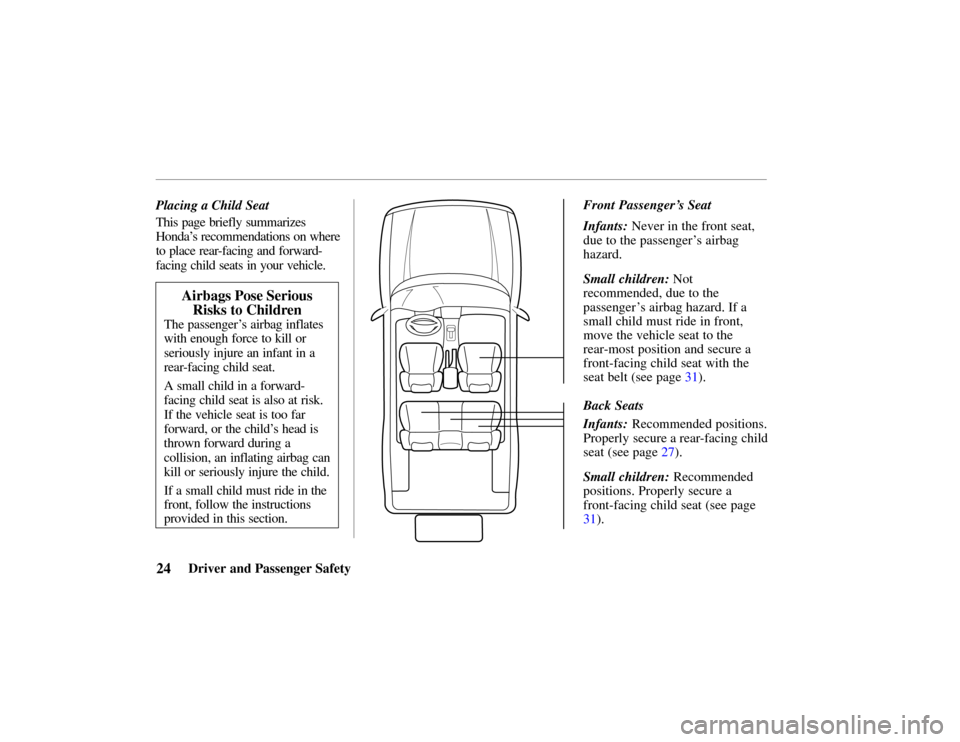
Driver and Passenger Safety24
Placing a Child Seat
This page briefly summarizes
Honda’s recommendations on where
to place rear-facing and forward-
facing child seats in your vehicle.
Airbags Pose Serious
Risks to Children
The passenger’s airbag inflates
with enough force to kill or
seriously injure an infant in a
rear-facing child seat.
A small child in a forward-
facing child seat is also at risk.
If the vehicle seat is too far
forward, or the child’s head is
thrown forward during a
collision, an inflating airbag can
kill or seriously injure the child.
If a small child must ride in the
front, follow the instructions
provided in this section. Front Passenger’s Seat
Infants:
Never in the front seat,
due to the passenger’s airbag
hazard.
Small children: Not
recommended, due to the
passenger’s airbag hazard. If a
small child must ride in front,
move the vehicle seat to the
rear-most position and secure a
front-facing child seat with the
seat belt (see page 31).
Back Seats
Infants: Recommended positions.
Properly secure a rear-facing child
seat (see page 27).
Small children: Recommended
positions. Properly secure a
front-facing child seat (see page
31).
Page 28 of 294

Driver and Passenger Safety 25
Installing a Child Seat
After selecting a proper child seat,
and a good position to install the
seat, there are three main steps to
installing the seat:
1. Properly secure the child seat
to the vehicle. All child seats
are designed to be secured to
the vehicle with the lap part of
a lap/shoulder belt. Some
child seats can be secured to
the vehicle’s LATCH
anchorage system instead. A
child whose seat is not
properly secured to the vehicle
can be endangered in a crash.
See pages 34, 38, and 39 for
instructions on how to
properly secure child seats in
this vehicle. 2.
Make sure the child seat is
firmly secured. After
installing a child seat, push
and pull the seat forward and
from side to side to verify that
it is secure.
To provide security during normal
driving maneuvers, as well as
during a collision, we recommend
that parents secure a child seat as
firmly as possible. However, a child seat does not
need to be “rock solid.” In some
vehicles or seating positions, it
may be difficult to install a child
seat so that it does not move at all.
Some side-to-side or back-and-
forth movement can be expected
and should not reduce the child
seat’
s effectiveness.
If the child seat is not secure, try
installing it in a different seating
position, or use a different style of
child seat that can be firmly
secured in the desired seating
position.
Page 29 of 294
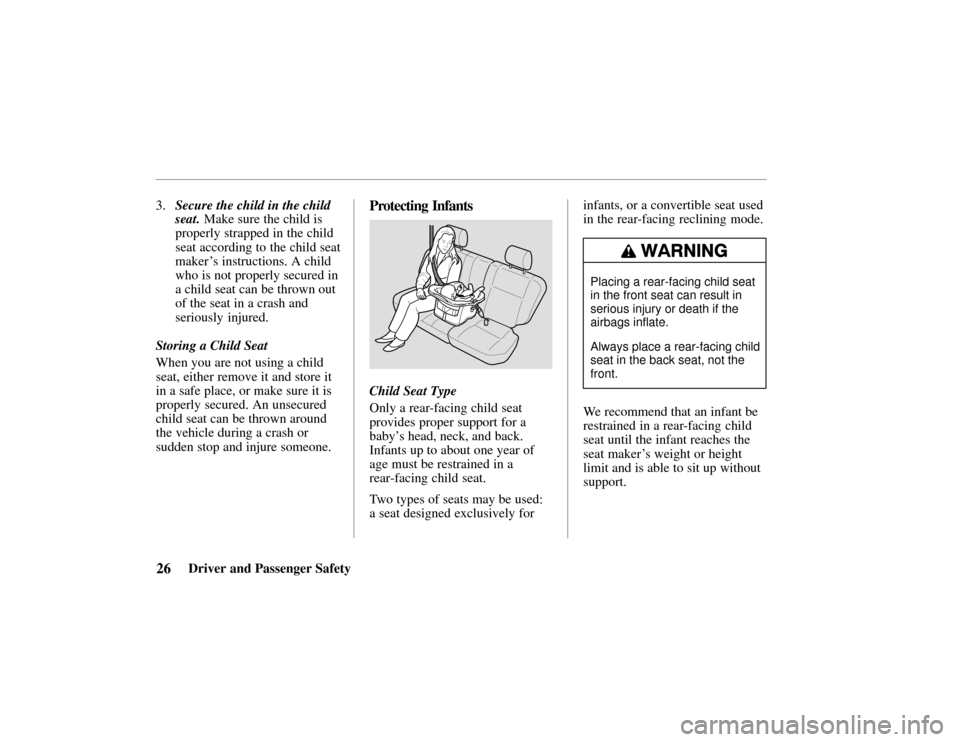
Driver and Passenger Safety26
3.Secure the child in the child
seat. Make sure the child is
properly strapped in the child
seat according to the child seat
maker ’ s instructions. A child
who is not properly secured in
a child seat can be thrown out
of the seat in a crash and
seriously injured.
Storing a Child Seat
When you are not using a child
seat, either remove it and store it
in a safe place, or make sure it is
properly secured. An unsecured
child seat can be thrown around
the vehicle during a crash or
sudden stop and injure someone.Protecting Infants
Child Seat Type
Only a rear-facing child seat
provides proper support for a
baby’ s head, neck, and back.
Infants up to about one year of
age must be restrained in a
rear-facing child seat.
Two types of seats may be used:
a seat designed exclusively for infants, or a convertible seat used
in the rear-facing reclining mode.
Placing a rear-facing child seat
in the front seat can result in
serious injury or death if the
airbags inflate.
Always place a rear-facing child
seat in the back seat, not the
front.
We recommend that an infant be
restrained in a rear-facing child
seat until the infant reaches the
seat maker
’s weight or height
limit and is able to sit up without
support.
Page 30 of 294
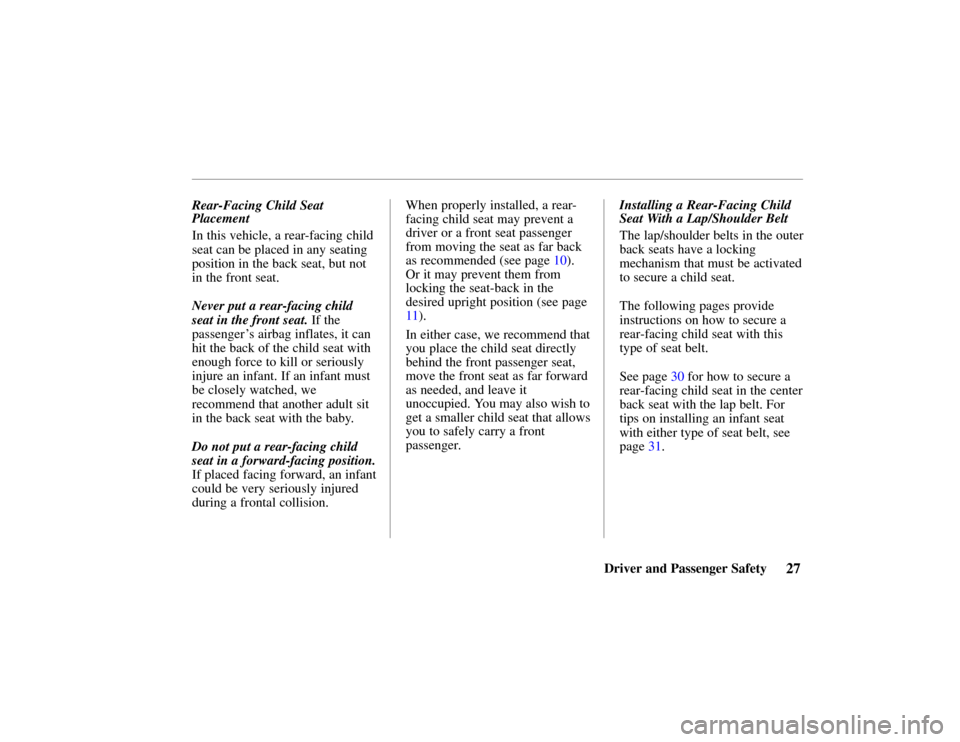
Driver and Passenger Safety 27
Rear-Facing Child Seat
Placement
In this vehicle, a rear-facing child
seat can be placed in any seating
position in the back seat, but not
in the front seat.
Never put a rear-facing child
seat in the front seat. If the
passenger’s airbag inflates, it can
hit the back of the child seat with
enough force to kill or seriously
injure an infant. If an infant must
be closely watched, we
recommend that another adult sit
in the back seat with the baby.
Do not put a rear-facing child
seat in a forward-facing position.
If placed facing forward, an infant
could be very seriously injured
during a frontal collision. When properly installed, a rear-
facing child seat may prevent a
driver or a front seat passenger
from moving the seat as far back
as recommended (see page 10).
Or it may prevent them from
locking the seat-back in the
desired upright position (see page
11).
In either case, we recommend that
you place the child seat directly
behind the front passenger seat,
move the front seat as far forward
as needed, and leave it
unoccupied. You may also wish to
get a smaller child seat that allows
you to safely carry a front
passenger.
Installing a Rear-Facing Child
Seat With a Lap/Shoulder Belt
The lap/shoulder belts in the outer
back seats have a locking
mechanism that must be activated
to secure a child seat.
The following pages provide
instructions on how to secure a
rear-facing child seat with this
type of seat belt.
See page 30 for how to secure a
rear-facing child seat in the center
back seat with the lap belt. For
tips on installing an infant seat
with either type of seat belt, see
page 31.
Page 32 of 294
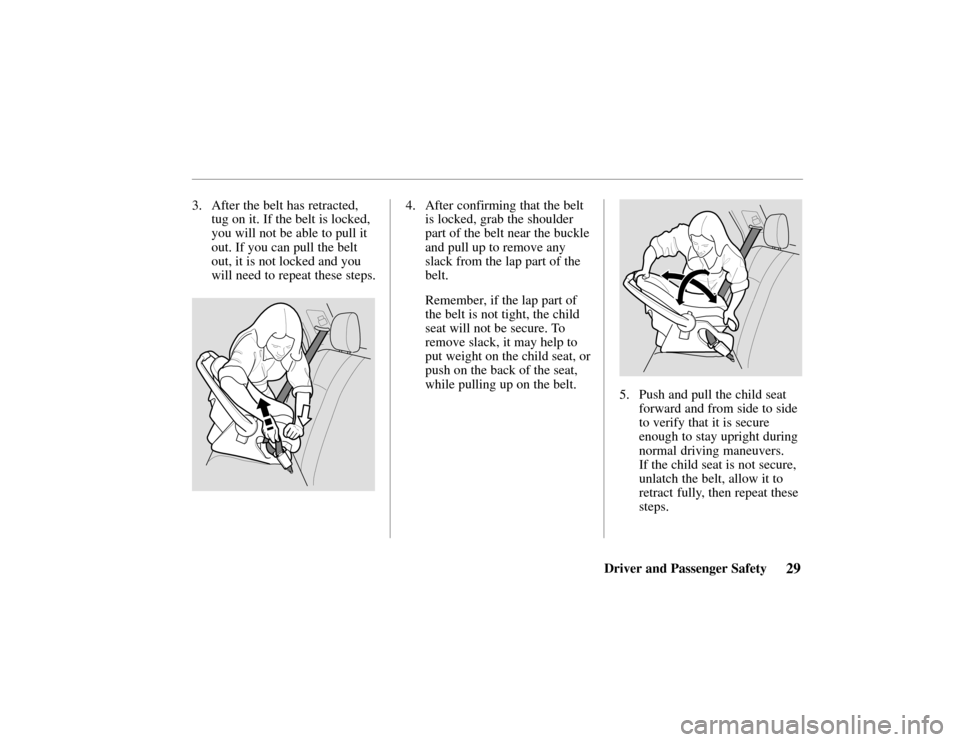
Driver and Passenger Safety29
3. After the belt has retracted,tug on it. If the belt is locked,
you will not be able to pull it
out. If you can pull the belt
out, it is not locked and you
will need to repeat these steps.4. After confirming that the beltis locked, grab the shoulder
part of the belt near the buckle
and pull up to remove any
slack from the lap part of the
belt.
Remember, if the lap part of
the belt is not tight, the child
seat will not be secure. To
remove slack, it may help to
put weight on the child seat, or
push on the back of the seat,
while pulling up on the belt.
5. Push and pull the child seat
forward and from side to side
to verify that it is secure
enough to stay upright during
normal driving maneuvers.
If the child seat is not secure,
unlatch the belt, allow it to
retract fully, then repeat these
steps.